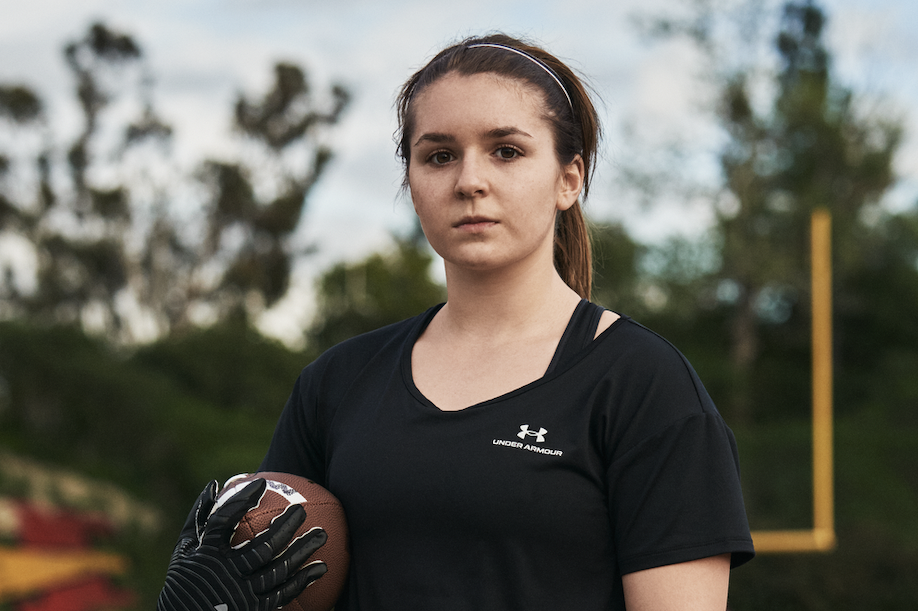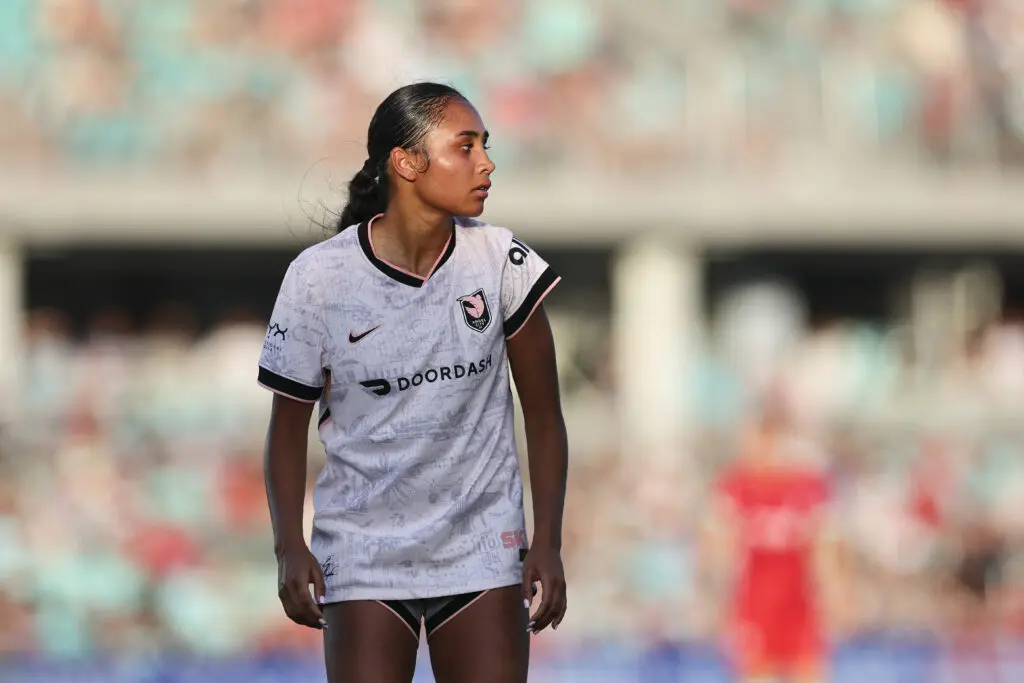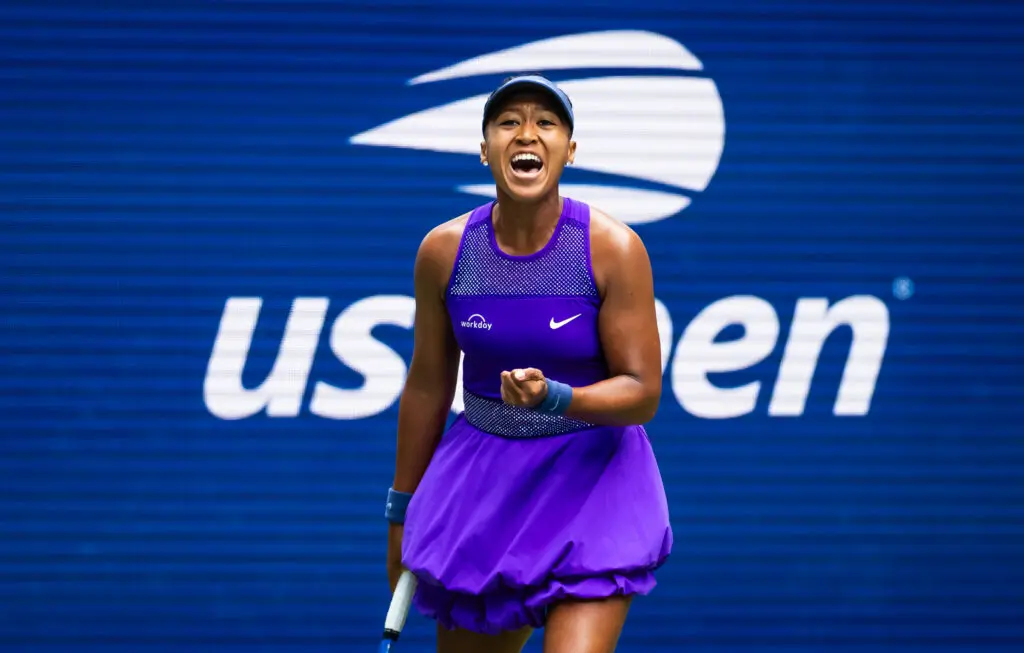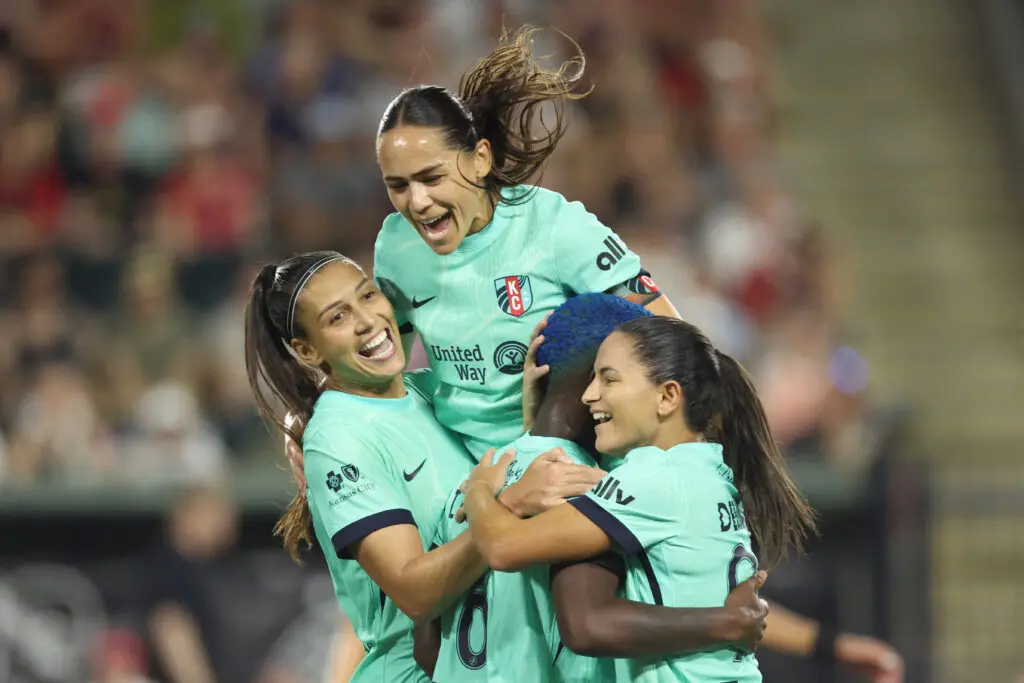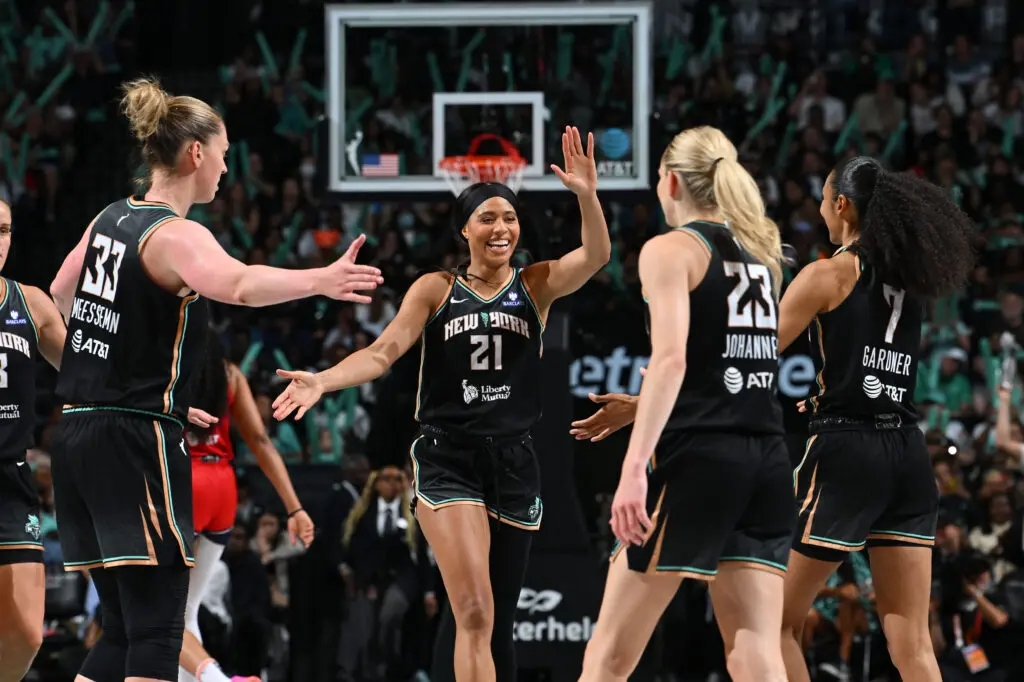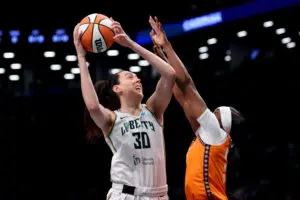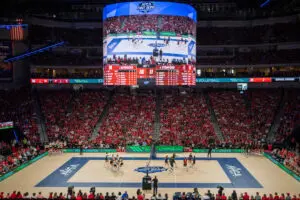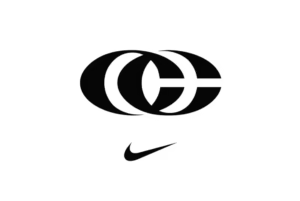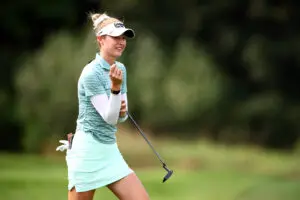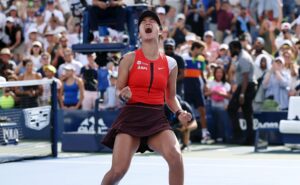When she was 9 years old, Sam Gordon just wanted to play football.
She didn’t plan on becoming a viral YouTube star. But that’s exactly what happened. In 2012, she was thrust into the national spotlight when her father, Brent, uploaded a highlight reel of her running roughshod all over the field during a youth football game, with the football tucked tightly under her arm and her blonde ponytail peeking out of the back of her helmet.
Run after run, little Sam juked defenders out of their cleats, broke tackles and sprinted her way to the end zone.
“When I first stepped on the football field, I didn’t think anything of it — that I was a girl doing something or I was gonna change the world by making this play,” Sam, now 19, says. “I just loved playing football and that was it going forward, too.
“When I look back at it in hindsight, I see how little there was with girls’ involvement in football and that it was such a story because nobody had seen a girl playing against the boys yet.”
Three days later, the video had amassed almost five million views and Sam became known as “Sweet Feet.” She appeared on ESPN, Good Morning America and other nationally televised programs. She was featured in Sports Illustrated and on the cover of the Wheaties cereal box — an honor reserved for superstar athletes like Michael Jordan and Serena Williams. Sam even attended Super Bowl XLVII as a special guest of NFL Commissioner Roger Goodell, and she rubbed elbows with numerous celebrities and professional athletes, including Carli Lloyd, Shaq, Rebel Wilson and Snoop Dogg.
Now a sophomore at Columbia University, Sam is living a life that looks a lot like that of an average student. She’s majoring in film, playing on the soccer team and navigating the rigors of college. It’s been a decade since her viral video, giving her time to sit back and reflect on that period in her life, how the experience has shaped her and, in turn, how she has made a lasting impact on the evolution of women’s tackle football.
Breaking the mold
Brent Gordon saw firsthand how damaging gender stereotypes could be when friends and people in their local community actively discouraged his ex-wife from pursuing a career in accounting. Living in a conservative area of Utah, Brent knew she was being treated differently because she was a woman. And it stuck with him.
When his daughter was born, they decided to give her a gender neutral name. “I was intentional about that because I wanted to make sure that whatever she wanted to do, she could do,” Brent says.
Years later, after a divorce, Brent took on the role of single dad and used sports to pass the time and keep his kids busy. They’d eat dinner together before heading out to the yard, where games of football became a regular occurrence. Eventually, Sam inquired about playing on a team.
“When she asked me, ‘Hey, can I go play football,’ I was actually excited about it because I thought, ‘You know what, I think she can f— the other kids up,” says Brent with a wide grin. “And I think it’d be awesome. I really did. I thought she could. … She could show people that she could do just as well as anyone else.”
At first, Brent started filming highlights of Sam himself, just for fun. Through word of mouth, he discovered a company that would film them for him. Each week, he’d put together clips of Sam and post them on YouTube. At the most, he thought he’d get 25,000 or 30,000 views. He never anticipated going viral.
“The first three or four months after the video blew up, there was an intense amount of activity going on,” Brent says. “Especially for the first month, I only think [Sam] slept on her own maybe two or three nights. But she was loving it. She was having a blast, doing all these fun things and going to different events. And then it started to slow down for the next few months, and then at the end of the spring, it basically died out.”
“I still remember having a talk with my dad, and there was a chance to go to New York for another interview and I was just like, ‘Noooo.’ Like, I don’t want to do another one of these,” Sam says. “So there were times when it was a lot, but overall, I found it very fun.”
For the most part, Sam’s moment in the limelight had been a good experience. Aside from a few YouTube comments from men twice her age saying they could “destroy her on the field,” the response was positive and affirming.
But when football season rolled around again, Sam felt the shift. In her first season, she scored 25 touchdowns and had 10 extra point conversions. She ran for 1,911 yards (8.2 yards per carry) and racked up 65 tackles. She felt pressured to keep the momentum going, and every time she had the ball in her hands, she wanted to make a big play.
“When I came back that next season, I definitely had a target on my back. It was a whole different level,” Sam says. “That first year, it was my ponytail and that was what set me apart. And the next year it was like, ‘That’s the girl that’s famous and that’s the one that was making the highlight reel, so we need to go crush her.’”
Even though she was still having fun playing football, Sam says it was stressful at times. No matter how many touchdowns she scored, how many yards she gained or how many tackles she made, she felt she had to keep proving that girls could play, too, and that it all rested on her tiny shoulders.
Not long after Sam’s viral video and others that followed, parents would continuously come up to Brent and ask him how their daughters could get involved in football. Those conversations stuck with him.
He knew the interest for girls wanting to play was there. He just had no idea how much there actually was.


The dawn of a new league
In March 2015, 12-year-old Sam spoke at a local Utah middle school assembly and asked if there were any girls in the audience who wanted to play football.
“I was there with her,” Brent says. “It seemed like almost every hand went up.”
At the time, Brent knew that Crys Sacco — a former semi-pro women’s football player and middle school football coach — was interested in starting a girls’ tackle football league in Utah. The day after the assembly, Brent called Sacco and told him that Sam could help promote and market the league.
Sacco was in.
Together, Brent and Sacco set up the non-profit organization, created a website and put together a board of directors. They hired coaches, ordered jerseys and equipment and scheduled playing fields. In May 2015, they held their first tryouts for the Utah Girls Tackle Football League. There were only four teams and 50 open roster spots available, but they filled up in a single week.
“I get the credit for founding [the Utah Girls Tackle Football League], but it was also my dad and some other people who had been wanting to start a league for a while,” Sam says. “And it was such a quick turnaround.”
Today, the UGTFL is thriving. The league is comprised of 34 teams, with over 600 players and four divisions: third and fourth grade, fifth and sixth grade, seventh and eighth grade, and high school.
“The Utah Girls Tackle Football League wouldn’t be what it is without Brent and Sam. I love them dearly,” says Sacco, who recently stepped down as league president but still serves as a coach and an active board member. “Brent has been a mentor, and Sam has been paving the way for girls’ and women’s football since she was 9 years old.”
This past summer, the UGTFL got another boost when Under Armour stepped in to partner with Sam and the league as a sponsor and to develop the first football cleat designed specifically for girls.
“The women’s Blur Smoke Cleat that all the girls in our league were wearing this last season is amazing,” Sam says. “It’s been great to have your own and not have to wear a soccer cleat or a baseball cleat to find one that fits. And it also shows that you are meant to play this game, that you have a cleat that’s provided for you, women’s football.”
Some companies and brands are quick to jump on the women’s sports bandwagon on social media, lending their support with statements and catchy phrases. But both Sam and Brent say Under Armour is taking that next step by putting action behind its words.
“When Under Armour came out and said, ‘We want to support you,’ it was like, we kept getting, ‘No, no, no,’ from everyone. To finally have someone to say, ‘We’re here and we’re on your side,’ that meant a lot to me,” Brent says.
He knew Under Armour wasn’t just going to put Sam in a commercial and call it a day. They were going to support the league by providing uniforms, front some of the operating costs and facilitate getting the championship games played at the University of Utah — just like the boys.
Under Armour also helped organize two girls’ tackle football summer camps, one in California and the other in Utah, each for 100 participants. Both were fully attended.
For Sam, it’s yet another affirmation that girls’ tackle football is growing and evolving.
“It isn’t known that football is a sport that women/girls can play. It’s difficult to battle the stereotypes that go hand-in-hand with women and contact/physical sports,” she says. “You have people who are pushing against it sometimes, like those YouTube comments. And you’ve got to not look towards those but find like-minded people who are willing to fight the fight and get to that next level.”
“All the time, I tell Sam this, ‘You know, we don’t need to change people’s opinions,” Brent adds. “What we need to do is find people who already agree with us.’ And that’s what we’re doing.”

The ongoing fight for women’s football
Sam never imagined having to give up playing tackle football. But after graduating high school, she didn’t have much of a choice. Sam aged out of the UGTFL, and there’s no option to play women’s tackle football at Columbia — nor at any college or university. Joining a semi-pro league would cost money and require a generous time commitment, two things a college student can’t readily afford.
“I miss [football] so much, I joined the rugby team,” Sam says. “It’s such an untapped opportunity.”
Sam Rapoport, NFL senior director of diversity, equality and inclusion and a UGTFL board member, is actively invested in growing women’s football and providing opportunities for women to become involved in football through NFL programs. She views the lack of a sustainable and consistent pipeline as a glaring issue.
“The problem is that girls growing up don’t get to see the future of the sport and what they could do with it,” Rapoport says. “Girls’ tackle football needs to be further legitimized. Girls need to play it across the entire country. It needs to be a high school sport, which would then lead into all divisions of college football so girls could get college scholarships — not just in NAIA but other places as well — and then that would ultimately lead up to women’s professional or semi-professional.”
Brent agrees. It’s part of the reason why he filed a Title IX lawsuit against the Utah School District in 2017.
“Our goal from Day 1, and it might sound a little far-fetched, but for real, when we started the lawsuit in 2017, the goal was to create a pipeline,” he says. “Our goal is to see girls have high school football teams, then college football teams, and now you’ve got a pipeline to fill talent on a professional league roster.”
The lawsuit stipulates that the Utah School District is in violation of Title IX because they do not offer the same athletic opportunities for girls at the high school level as they do for boys. What it comes down to, Brents says, aren’t the number of sports available but the number of participants across the board.
“So you have football over here. And some of these boys’ high school football rosters are 120 to 140 deep,” he says. “And then say you have girls’ golf on the other side, and you only have eight to 12 participants. That doesn’t comply with Title IX. And I knew that.”
The solution, Brent told the Utah School District, is to offer girls’ tackle football.
“They were like, ‘No, we’re going to pass,’ so I sued them,” he says.
Under Title IX and the equal protection clause, Brent is confident they can mandate the district to offer girls’ football. Arguments in the Tenth Circuit Court of Appeals — on whether Utah schools can avoid liability for Title IX by being part of a high school activities association but refusing to sanction girls’ tackle football — began the first week of October. A decision is expected to be reached in three months to one year.
In the meantime, the UGTFL soldiers on as one of the few girls’ tackle football leagues in the country. And Brent continues the fight for equality, as both the proud father of a football phenom and a women’s sports advocate.
As for Sam, she’s focused on enjoying college. Her time in the spotlight was exciting, but she learned at such a young and vulnerable age to not let it define her.
Not long after the highlight video went viral, Sam began uploading other clips to YouTube showing her hanging out with friends, telling stories and being a goofy teenager. She wanted the world to know she was more than just a ponytailed kid in a football helmet. The balance helped her navigate her sudden fame and kept her grounded.

“She didn’t set out to be this pioneer or anything like that. She just wanted to play the sport that she loved. But she is that for people — she is the pioneer that started the girls’ tackle football movement,” Rapoport says. “And in 10, 15, 20, 100 years, when girls are finally playing tackle football in leagues that have been created to give them the opportunity, it will be because of Sam.”
Even though Sam isn’t able to play tackle football anymore, she’s still looking for a way to be a part of the sport and its continuing evolution. But much like a Hail Mary pass, what that means for her in the future is up in the air.
“I’ve definitely thought about staying involved with football, and I don’t know what route that is,” she says. “One of the reasons I’m picking film [for my major] is being a sports broadcaster or something like that, where I’m getting to be involved in the game and still be in a space where there needs to be more women involved. Coaching and all that might be on the plate.
“I’m still figuring it out.”
Lyndsey D’Arcangelo is a contributing writer at Just Women’s Sports, covering the WNBA and college basketball. She also contributes to The Athletic and is the co-author of “Hail Mary: The Rise and Fall of the National Women’s Football League.” Follow Lyndsey on Twitter @darcangel21.
